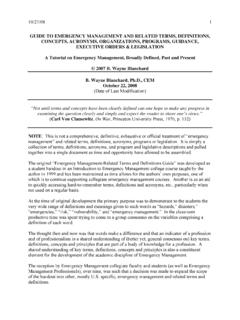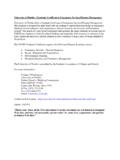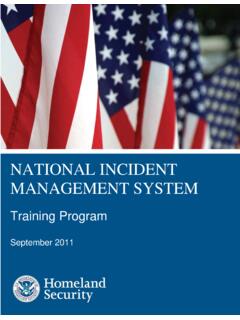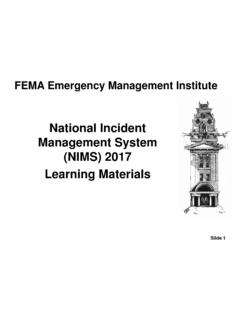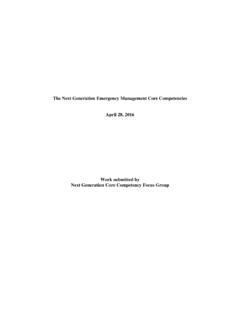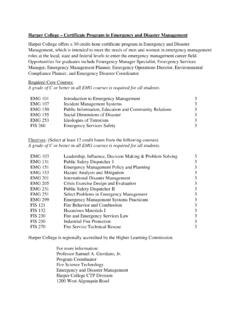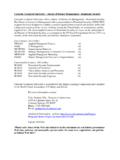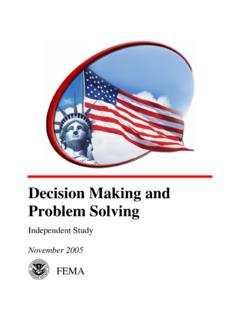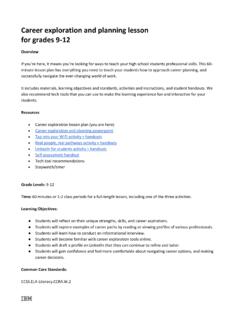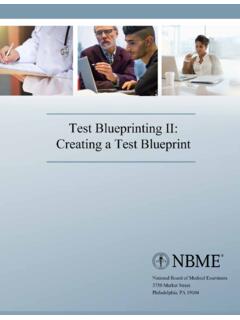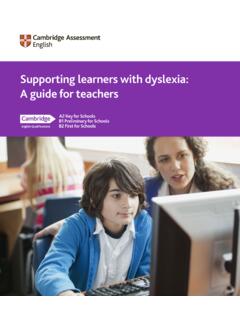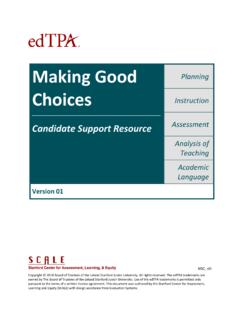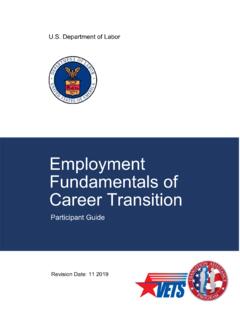Transcription of Lesson 1: Understanding Communication Basics
1 EFFECTIVE Communication This page intentionally left blank. Lesson 1. Understanding Communication Basics This page intentionally left blank. Lesson 1. Understanding Communication Basics Effective Communication ( ) February 2014 Instructor Guide Page Lesson Objectives At the end of this Lesson , the participants will be able to: Indicate the value of empathic listening and effective feedback. Indicate how speakers and listeners nonverbal cues impact Communication . Identify vocal factors that contribute to effective Communication . Indicate how actively engaging the audience contributes to effective Communication . Assess your current Communication skills. Scope Course Overview Lesson Overview and Objectives Effective Communication The Communication Process Communication Basics Listening Activity: Listening Self-Assessment Communicating Nonverbally Using Your Voice Activity: Using Your Voice Engaging Your Audience Activity: Open-Ended vs.
2 Direct Questions Activity: Analyze Your Basic Communication Skills Summary and Transition Methodology The Lesson will begin with an overview of the course and a review of the course objectives. A video will discuss the importance of effective Communication in emergency management. The participants will then learn about the Communication process and review Communication Basics . Participants will complete a self-assessment of their listening skills and consider how nonverbal Communication impacts one s effectiveness in transmitting and receiving messages. The instructor will review methods for using your voice to improve your Communication skills and present strategies for engaging the audience. A video will summarize guidance on using one s voice. Participants will discuss the purposes of open-ended and direct questions. The participants will conclude the Lesson by completing a self-assessment of their Communication skills.
3 Materials PowerPoint visuals and a computer display system Instructor Guide Student Manual Lesson 1. Understanding Communication Basics Effective Communication ( ) Page Instructor Guide February 2014 Time Plan A suggested time plan for this Lesson is shown below. More or less time may be required, based on the experience level of the group. Topic Time Course Overview 15 minutes Lesson Overview and Objectives 2 minutes Effective Communication 13 minutes The Communication Process 5 minutes Communication Basics 5 minutes Listening 5 minutes Activity: Listening Self-Assessment 10 minutes Communicating Nonverbally 5 minutes Using Your Voice 10 minutes Activity: Using Your Voice 10 minutes Engaging the Audience 10 minutes Activity: Open-Ended vs. Direct Questions 10 minutes Activity: Analyze Your Basic Communication Skills 15 minutes Summary and Transition 5 minutes Total Time 2 hours Two optional activities are included with this Lesson , to be used at the instructor s discretion if time permits: Optional Activity #1: Communicating Nonverbally (15 minutes) Optional Activity #2: Using Your Voice (5 minutes) Lesson 1.
4 Understanding Communication Basics Effective Communication ( ) February 2014 Instructor Guide Page COURSE OVERVIEW Visual Key Points Welcome to : Effective Communication . Instructor Note: Introduce yourself and any other instructors. Describe your background and your experience as an effective communicator. Lesson 1. Understanding Communication Basics Effective Communication ( ) Page Instructor Guide February 2014 COURSE OVERVIEW Visual Key Points Instructor Note: Review the following information and answer any additional questions that participants may have. Sign-in sheet Course evaluation forms Site logistics o Emergency procedures o Breaks o Restrooms o Cell phones and other electronic devices silent Lesson 1. Understanding Communication Basics Effective Communication ( ) February 2014 Instructor Guide Page COURSE OVERVIEW Visual Key Points Instructor Note: Conduct the following introduction activity.
5 Tell the participants to: Pair with another person (if there is an odd number of participants, there will be one group of three). Interview that person about their prior emergency management experience. Allow approximately 5 minutes for participants to interview one another. Ask each participant to introduce his or her partner. Lesson 1. Understanding Communication Basics Effective Communication ( ) Page Instructor Guide February 2014 COURSE OVERVIEW Visual Key Points Being able to communicate effectively is a necessary and vital part of every emergency management professional s job. This course is designed to improve your Communication skills. During an emergency, it is especially challenging and important to communicate accurate information clearly to the target audience. Disaster survivors generally look for someone who can communicate valuable guidance, provide leadership, and lead them in problem solving. When you successfully fill that role, you act to reassure survivors that their government and private organizations are working toward community recovery.
6 Finely tuned Communication skills are also important tools during the emergency planning phase when educating the public about preparedness. In addition, being able to communicate effectively with other emergency management personnel facilitates collaborative working relationships and partnerships. Lesson 1. Understanding Communication Basics Effective Communication ( ) February 2014 Instructor Guide Page COURSE OVERVIEW Visual Key Points At the conclusion of this course, you should be able to: Identify factors that contribute to and detract from effective Communication . Develop a strategy for ensuring that emergency communications meet the needs of the whole community, including those with access and functional needs. Identify strategies for communicating effectively in emergency situations. Identify strategies for improving your oral presentation skills. Lesson 1. Understanding Communication Basics Effective Communication ( ) Page Instructor Guide February 2014 COURSE OVERVIEW Visual Key Points This course is comprised of four lessons: Lesson 1 offers an overview of Communication Basics .
7 Lesson 2 addresses the importance of communicating with the whole community. Lesson 3 presents strategies for communicating effectively in emergency situations. Lesson 4 focuses on improving your oral presentation skills. Lesson 1. Understanding Communication Basics Effective Communication ( ) February 2014 Instructor Guide Page EFFECTIVE Communication Visual Key Points The remainder of this Lesson presents information about basic factors that contribute to effective Communication . At the completion of this Lesson , you should be able to: Indicate the value of empathic listening and effective feedback. Indicate how speakers and listeners nonverbal cues impact Communication . Identify vocal factors that contribute to effective Communication . Indicate how actively engaging the audience contributes to effective Communication . Assess your current Communication skills. Lesson 1. Understanding Communication Basics Effective Communication ( ) Page Instructor Guide February 2014 EFFECTIVE Communication Visual Instructor Notes: Present the following key points.
8 Transcript: Effective Communication is essential in the workplace. The average worker spends 50 percent of the day communicating, and one-fourth of all workplace mistakes are the result of poor Communication . As an emergency management professional, you need to be a skillful communicator to achieve your objectives. Your role may involve communicating one-on-one or in small-group discussions; making public presentations at briefings, community meetings, and press conferences; taking part in media interviews; and issuing announcements and warnings. You must be able to reach a broad audience that includes response partners and other colleagues, private sector and nonprofit organizations, the media, and a very diverse public. Effective Communication is essential before, during, and after an incident. During routine operations, strong Communication skills enable you to engage in collaborative planning and promote safety awareness in the community.
9 During an incident, communicating clearly and accurately can help to reassure survivors and assist them in making responsible choices. Following an incident, effective Communication helps create a common Understanding of the situation so the whole community can work together toward recovery. This course will help you understand what effective Communication entails and identify ways to improve your Communication skills. Lesson 1. Understanding Communication Basics Effective Communication ( ) February 2014 Instructor Guide Page EFFECTIVE Communication Visual Key Points Discussion Question: Think about a great current or historical orator, speaker, or presenter. What characteristics made that person so effective? Instructor Note: Facilitate a discussion around the question. If not suggested by the participants, add that effective communicators: Project conviction and passion for their subject matter. Have credibility.
10 Make even a large audience feel a personal connection. Appear poised and confident. Are well prepared and organized. Use clear and concise language. Use nonverbal gestures that draw attention while not being distracting. Vary the pace and know when to pause to make a point. Energize the listeners with a call to action. Maintain a professional demeanor. Lesson 1. Understanding Communication Basics Effective Communication ( ) Page Instructor Guide February 2014 THE Communication PROCESS Visual Key Points Being an effective communicator involves establishing a personal connection with the audience and using basic Communication tools to reach that audience. To communicate effectively whether your audience is a single individual or a large group it is helpful to understand the basic skills that form the building blocks of effective Communication . Let s begin with a brief look at what happens when two people communicate.
